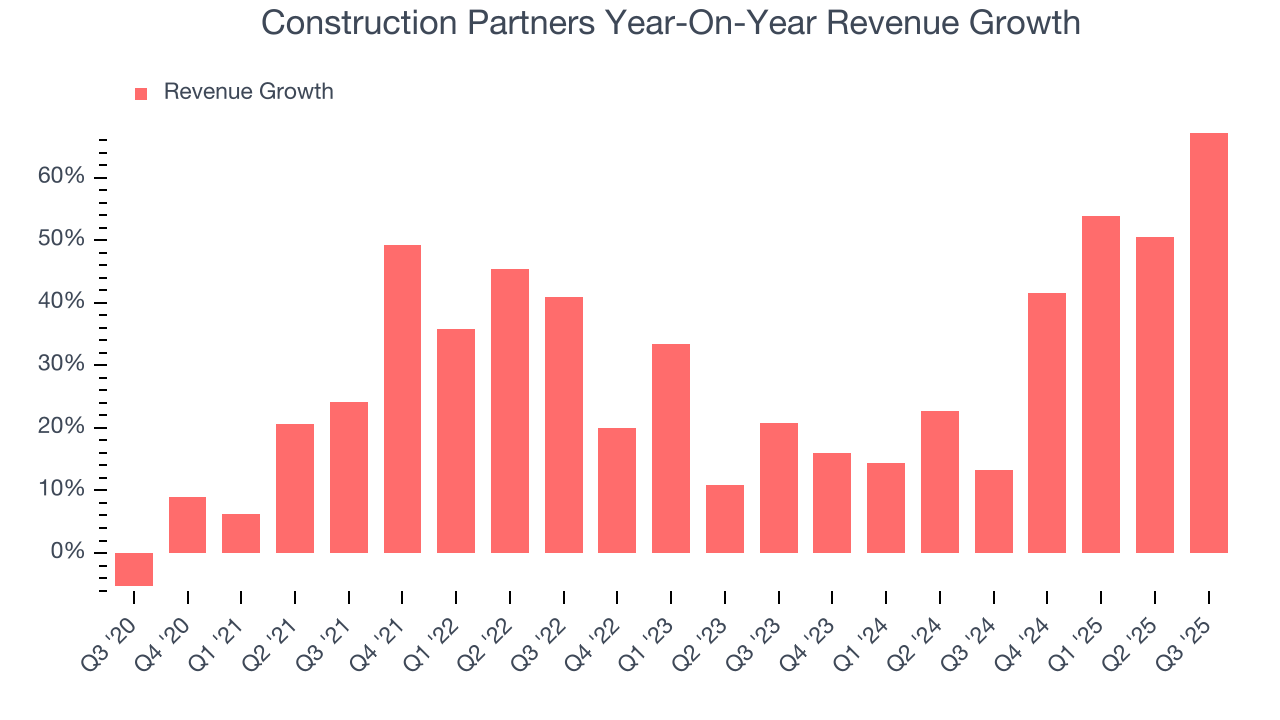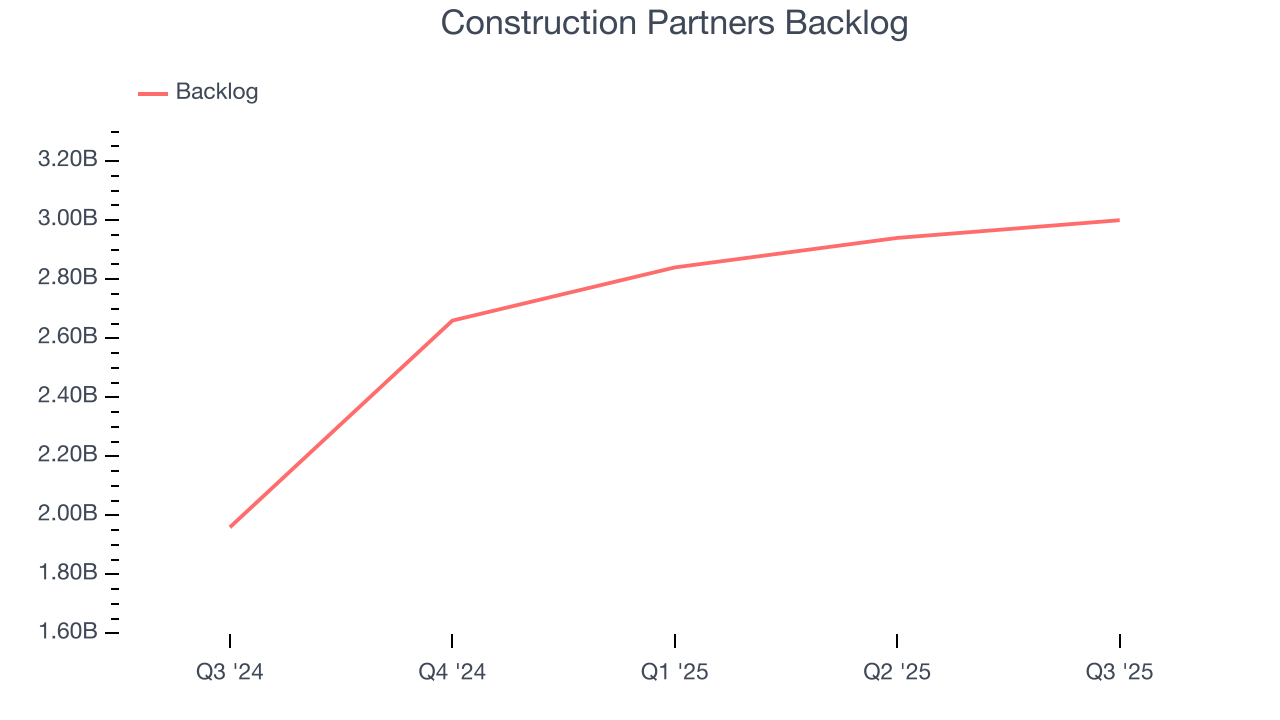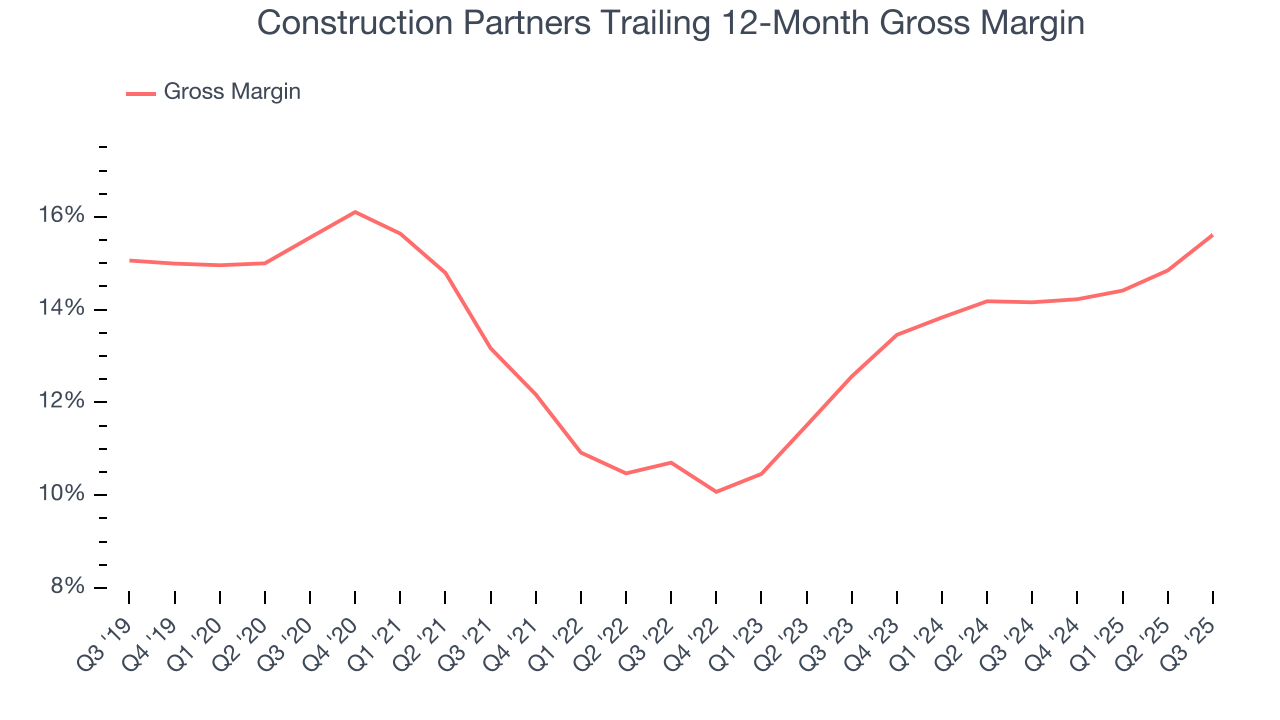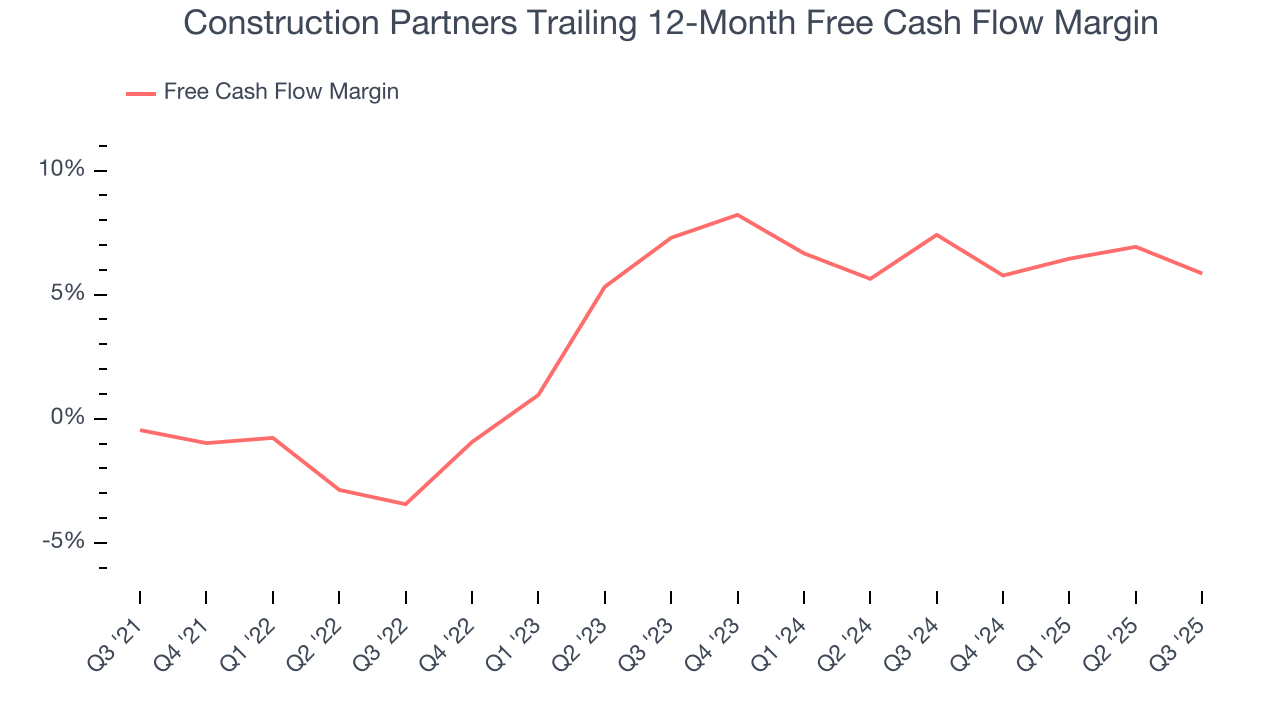
Construction Partners (ROAD)
We’re bullish on Construction Partners. Its revenue and EPS are projected to skyrocket next year, an optimistic sign for its share price.― StockStory Analyst Team
1. News
2. Summary
Why We Like Construction Partners
Founded in 2001, Construction Partners (NASDAQ:ROAD) is a civil infrastructure company that builds and maintains roads, highways, and other infrastructure projects.
- Annual revenue growth of 29.1% over the last five years was superb and indicates its market share increased during this cycle
- Earnings per share have massively outperformed its peers over the last five years, increasing by 23% annually
- Expected revenue growth of 22.3% for the next year suggests its market share will rise


We have an affinity for Construction Partners. The price looks reasonable in light of its quality, and we think now is a prudent time to invest.
Why Is Now The Time To Buy Construction Partners?
High Quality
Investable
Underperform
Why Is Now The Time To Buy Construction Partners?
Construction Partners is trading at $104.96 per share, or 37.2x forward P/E. Valuation is above that of many industrials companies, but we think the price is justified given its business fundamentals.
Entry price certainly impacts returns, but over a long-term, multi-year period, business quality matters much more than where you buy a stock.
3. Construction Partners (ROAD) Research Report: Q3 CY2025 Update
Civil infrastructure company Construction Partners (NASDAQ:ROAD) met Wall Streets revenue expectations in Q3 CY2025, with sales up 67.2% year on year to $899.8 million. The company’s full-year revenue guidance of $3.45 billion at the midpoint came in 0.8% above analysts’ estimates. Its GAAP profit of $1.02 per share was 7.7% below analysts’ consensus estimates.
Construction Partners (ROAD) Q3 CY2025 Highlights:
- Revenue: $899.8 million vs analyst estimates of $895.9 million (67.2% year-on-year growth, in line)
- EPS (GAAP): $1.02 vs analyst expectations of $1.11 (7.7% miss)
- EBITDA guidance for the upcoming financial year 2026 is $530 million at the midpoint, above analyst estimates of $521.8 million
- Operating Margin: 11.2%, up from 8.5% in the same quarter last year
- Free Cash Flow Margin: 8.8%, down from 15.6% in the same quarter last year
- Backlog: $3 billion at quarter end, up 53.1% year on year
- Market Capitalization: $5.84 billion
Company Overview
Founded in 2001, Construction Partners (NASDAQ:ROAD) is a civil infrastructure company that builds and maintains roads, highways, and other infrastructure projects.
The company specializes exclusively in civil engineering infrastructure projects in the Southeastern United States. In addition to roads and highways, Construction Partners works on municipal projects like airport runways, sidewalks, bike paths, and drainage and sewer systems.
Its product and service offerings include the paving, grading, and construction processes of roads, highways, sidewalks, and drainage systems. These processes include implementing traffic control and safety measures for high-danger work areas on construction sites or asphalt production for the material needed to build infrastructure. The company also operates repair and upgrading services to existing bridges, roads, and other infrastructure.
Construction Partners generates revenue mostly through the construction and maintenance of public infrastructure. Revenue stems from contracts with state and local governments and includes the recurring maintenance needed to maintain the quality and safety of the infrastructure. The company also generates revenue through private sector projects requiring its paving, production, or engineering skills, like commercial site developments.
4. Construction and Maintenance Services
Construction and maintenance services companies not only boast technical know-how in specialized areas but also may hold special licenses and permits. Those who work in more regulated areas can enjoy more predictable revenue streams - for example, fire escapes need to be inspected every five years. More recently, services to address energy efficiency and labor availability are also creating incremental demand. But like the broader industrials sector, construction and maintenance services companies are at the whim of economic cycles as external factors like interest rates can greatly impact the new construction that drives incremental demand for these companies’ offerings.
Companies competing against Construction Partners include Vulcan Materials (NYSE:VMC), Granite Construction (NYSE:GVA), and Martin Marietta Materials (NYSE:MLM)
5. Revenue Growth
A company’s long-term sales performance is one signal of its overall quality. Any business can put up a good quarter or two, but many enduring ones grow for years. Over the last five years, Construction Partners grew its sales at an incredible 29.1% compounded annual growth rate. Its growth surpassed the average industrials company and shows its offerings resonate with customers, a great starting point for our analysis.

Long-term growth is the most important, but within industrials, a half-decade historical view may miss new industry trends or demand cycles. Construction Partners’s annualized revenue growth of 34.1% over the last two years is above its five-year trend, suggesting its demand was strong and recently accelerated. 
We can dig further into the company’s revenue dynamics by analyzing its backlog, or the value of its outstanding orders that have not yet been executed or delivered. Construction Partners’s backlog reached $3 billion in the latest quarter and averaged 53.1% year-on-year growth over the last two years. Because this number is better than its revenue growth, we can see the company accumulated more orders than it could fulfill and deferred revenue to the future. This could imply elevated demand for Construction Partners’s products and services but raises concerns about capacity constraints. 
This quarter, Construction Partners’s year-on-year revenue growth of 67.2% was magnificent, and its $899.8 million of revenue was in line with Wall Street’s estimates.
Looking ahead, sell-side analysts expect revenue to grow 20.9% over the next 12 months, a deceleration versus the last two years. Despite the slowdown, this projection is admirable and implies the market sees success for its products and services.
6. Gross Margin & Pricing Power
Cost of sales for an industrials business is usually comprised of the direct labor, raw materials, and supplies needed to offer a product or service. These costs can be impacted by inflation and supply chain dynamics.
Construction Partners has bad unit economics for an industrials business, signaling it operates in a competitive market. As you can see below, it averaged a 13.7% gross margin over the last five years. That means Construction Partners paid its suppliers a lot of money ($86.29 for every $100 in revenue) to run its business. 
Construction Partners’s gross profit margin came in at 17.7% this quarter, up 2.1 percentage points year on year. Construction Partners’s full-year margin has also been trending up over the past 12 months, increasing by 1.5 percentage points. If this move continues, it could suggest better unit economics due to more leverage from its growing sales on the fixed portion of its cost of goods sold (such as manufacturing expenses).
7. Operating Margin
Construction Partners was profitable over the last five years but held back by its large cost base. Its average operating margin of 5.7% was weak for an industrials business. This result isn’t too surprising given its low gross margin as a starting point.
On the plus side, Construction Partners’s operating margin rose by 4.7 percentage points over the last five years, as its sales growth gave it operating leverage.

This quarter, Construction Partners generated an operating margin profit margin of 11.2%, up 2.7 percentage points year on year. The increase was encouraging, and because its operating margin rose more than its gross margin, we can infer it was more efficient with expenses such as marketing, R&D, and administrative overhead.
8. Earnings Per Share
We track the long-term change in earnings per share (EPS) for the same reason as long-term revenue growth. Compared to revenue, however, EPS highlights whether a company’s growth is profitable.
Construction Partners’s EPS grew at an astounding 18.6% compounded annual growth rate over the last five years. Despite its operating margin improvement during that time, this performance was lower than its 29.1% annualized revenue growth, telling us that non-fundamental factors such as interest and taxes affected its ultimate earnings.

We can take a deeper look into Construction Partners’s earnings to better understand the drivers of its performance. A five-year view shows Construction Partners has diluted its shareholders, growing its share count by 8%. This dilution overshadowed its increased operational efficiency and has led to lower per share earnings. Taxes and interest expenses can also affect EPS but don’t tell us as much about a company’s fundamentals. 
Like with revenue, we analyze EPS over a shorter period to see if we are missing a change in the business.
For Construction Partners, its two-year annual EPS growth of 39.9% was higher than its five-year trend. We love it when earnings growth accelerates, especially when it accelerates off an already high base.
In Q3, Construction Partners reported EPS of $1.02, up from $0.56 in the same quarter last year. Despite growing year on year, this print missed analysts’ estimates, but we care more about long-term EPS growth than short-term movements. Over the next 12 months, Wall Street expects Construction Partners’s full-year EPS of $1.83 to grow 61.3%.
9. Cash Is King
If you’ve followed StockStory for a while, you know we emphasize free cash flow. Why, you ask? We believe that in the end, cash is king, and you can’t use accounting profits to pay the bills.
Construction Partners has shown weak cash profitability over the last five years, giving the company limited opportunities to return capital to shareholders. Its free cash flow margin averaged 4.3%, subpar for an industrials business.
Taking a step back, an encouraging sign is that Construction Partners’s margin expanded by 6.3 percentage points during that time. The company’s improvement shows it’s heading in the right direction, and we can see it became a less capital-intensive business because its free cash flow profitability rose more than its operating profitability.

Construction Partners’s free cash flow clocked in at $78.94 million in Q3, equivalent to a 8.8% margin. The company’s cash profitability regressed as it was 6.9 percentage points lower than in the same quarter last year, but it’s still above its five-year average. We wouldn’t put too much weight on this quarter’s decline because capital expenditures can be seasonal and companies often stockpile inventory in anticipation of higher demand, causing short-term swings. Long-term trends are more important.
10. Return on Invested Capital (ROIC)
EPS and free cash flow tell us whether a company was profitable while growing its revenue. But was it capital-efficient? Enter ROIC, a metric showing how much operating profit a company generates relative to the money it has raised (debt and equity).
Although Construction Partners has shown solid business quality lately, it historically did a mediocre job investing in profitable growth initiatives. Its five-year average ROIC was 6.2%, somewhat low compared to the best industrials companies that consistently pump out 20%+.

We like to invest in businesses with high returns, but the trend in a company’s ROIC is what often surprises the market and moves the stock price. Over the last few years, Construction Partners’s ROIC averaged 3.3 percentage point increases each year. its rising ROIC is a good sign and could suggest its competitive advantage or profitable growth opportunities are expanding.
11. Balance Sheet Assessment
Construction Partners reported $159 million of cash and $1.69 billion of debt on its balance sheet in the most recent quarter. As investors in high-quality companies, we primarily focus on two things: 1) that a company’s debt level isn’t too high and 2) that its interest payments are not excessively burdening the business.

With $423.7 million of EBITDA over the last 12 months, we view Construction Partners’s 3.6× net-debt-to-EBITDA ratio as safe. We also see its $92.22 million of annual interest expenses as appropriate. The company’s profits give it plenty of breathing room, allowing it to continue investing in growth initiatives.
12. Key Takeaways from Construction Partners’s Q3 Results
It was great to see Construction Partners’s full-year EBITDA guidance top analysts’ expectations. We were also glad its full-year revenue guidance slightly exceeded Wall Street’s estimates. On the other hand, its EPS missed. Zooming out, we think this was a mixed quarter. The market seemed to be hoping for more, and the stock traded down 6.9% to $97 immediately following the results.
13. Is Now The Time To Buy Construction Partners?
Updated: December 4, 2025 at 9:07 PM EST
Before deciding whether to buy Construction Partners or pass, we urge investors to consider business quality, valuation, and the latest quarterly results.
There are multiple reasons why we think Construction Partners is an elite industrials company. First of all, the company’s revenue growth was exceptional over the last five years. And while its low gross margins indicate some combination of competitive pressures and high production costs, its rising cash profitability gives it more optionality. On top of that, Construction Partners’s astounding EPS growth over the last five years shows its profits are trickling down to shareholders.
Construction Partners’s P/E ratio based on the next 12 months is 37.1x. Analyzing the industrials landscape today, Construction Partners’s positive attributes shine bright. We think it’s one of the best businesses in our coverage and like the stock at this price.
Wall Street analysts have a consensus one-year price target of $128 on the company (compared to the current share price of $105.11), implying they see 21.8% upside in buying Construction Partners in the short term.











